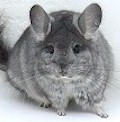Even though the original chinchillas were all grey, over the years breeders have been able to get a wide number of colors to come out in their fur. Here's a list with descriptions about each color to help you find the color you want. Keep in mind there is a variation of each color.
Standard - These guys are the 'normal' chinchilla and they match their cousins that still live in the wild. They have grey fur on their back and sides, with a white tummy. Beige - Beige chins range in color from lighter shades to darker. They will mostly have red eyes, and pink (sometimes freckled) ears. They also have white bellies. Ebony - One of the favorites is this black chinchilla. Ebonys will range from grey to solid black. They won't have a white belly like the standard, instead it will be a grey belly, and some even have a black belly that matches their back fur. Black Velvet - This color of chinchilla will be black on the top and get lighter as their fur wraps around their sides. They have a white belly and usually have a blue hue in their fur. Tans - These chins look a lot like the beige variety, except they carry the ebony gene which causes them not to have a white tummy like the beige chins do. They are usually solid brown throughout their whole body. White - There are a bunch of variations to the white chinchilla, but the most common is pure white, with red eyes and pink ears (sometimes with freckles) Mosaic - This is sort of a mix between the white and a standard color chinchilla. They will have patches of grey throughout their fur and darker ears and eyes. If you find a 'reverse mosaic' that just means that there is more grey on them and the patches are white fur. Violet - Violet colored chins are unfortunately not bright purple , but they are very soft looking and their fur will be grey with a blue hue to it. They look so soft because their fur doesn't have black tips like standard chins and they are fairly rare. Goldbars - This is one of the rarest colors of chins in the world today. They actually look gold on their back and it gets whiter as it comes down their sides. Their eyes are usually dark red and they have a white belly.Next, you should keep learning about your chinchilla so you know what he needs and when. For more information about the natural chinchilla colors and how you can make your chin feel at home, visit my website which is an online resource that has articles and information about chinchilla care and how to raise a happy chin that lives a full, healthy life.
